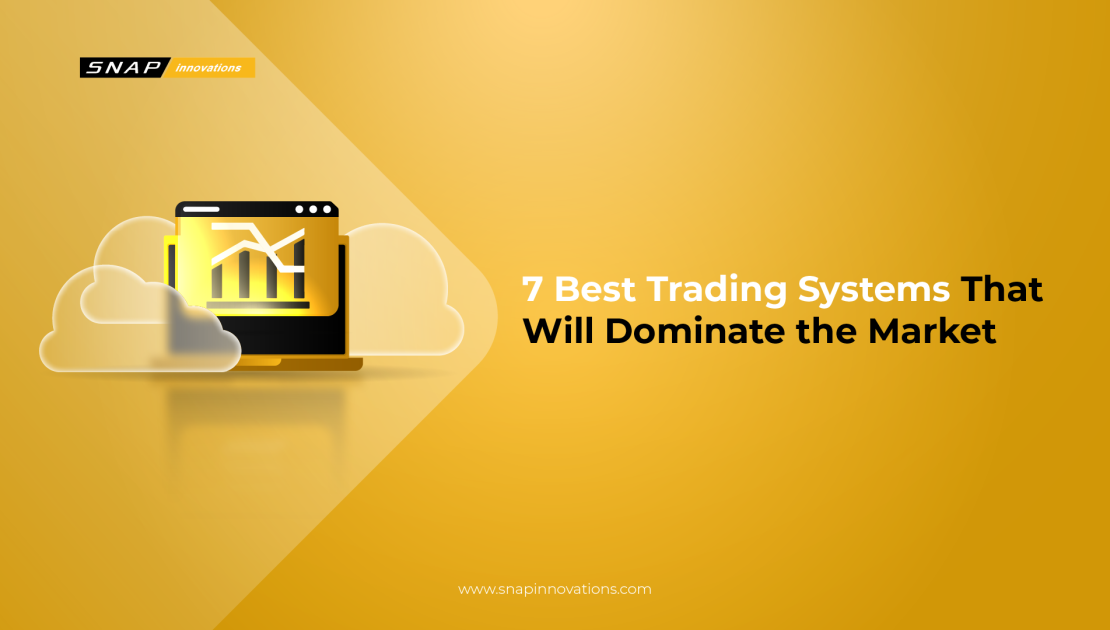7 Best Trading Systems That Will Dominate the Market in 2026

Developing a successful trading system is an essential factor to succeed in financial markets today. A trading system is not just a set of rules; it is an automated or manual framework that enables traders to act consistently and decisively, with limited emotional biases and mistakes. Trading systems can be as simple as trend following algorithms, or as advanced as time sensitive AI that alters its decision-making in the same way that you would, whenever there are changes in market direction in real-time.
As of 2026, traders can access many technologies and strategies, including statistical arbitrage, momentum trading, artificial intelligence systems, machine learning systems, and breakout strategies that capture changing market direction. In this article, you will learn about seven of the best trading systems, each will offer a distinct trading system, explain how they compare to one another, and give you guidance on what system you feel is best suited for you and your trading goals.
What Is a Trading System?
 A trading system is a predetermined, rules-based set of operations for entering trades and exiting trades, either long, short, or to realize profit or loss. This set of rules can be based on technical indicators, statistics, price patterns, or machine-learning signals. The basic purpose of a trading system is to limit emotional-based decision-making, allow consistent execution, and make it easier to scale your business.
A trading system is a predetermined, rules-based set of operations for entering trades and exiting trades, either long, short, or to realize profit or loss. This set of rules can be based on technical indicators, statistics, price patterns, or machine-learning signals. The basic purpose of a trading system is to limit emotional-based decision-making, allow consistent execution, and make it easier to scale your business.
Over time, trading systems have become more advanced than simply moving average crossovers and breakout rules; the capabilities have also matured to become data- driven frameworks, increased use of artificial intelligence for trading decisions, and aggregating risk controls in real-time, and using various levels of cloud-based execution environments.
7 Best Trading Systems That Will Dominate the Market in 2026
 Here are seven best trading systems for 2026, each of them have different styles, can offer different approaches to various market conditions and cater to different preferences among traders.
Here are seven best trading systems for 2026, each of them have different styles, can offer different approaches to various market conditions and cater to different preferences among traders.
1. Mean Reversion
Mean Reversion takes advantage of prices returning to their long-term average after an extended move. Mean reverting systems generally utilize indicators such as Bollinger Bands and RSI to pinpoint when conditions become too “overbought” or “oversold” and then execute a trade assuming a reversion is more likely.
Mean Reversion systems work best in range-bound markets and especially during situations when volatility spikes. Mean Reversion systems will generally always form an automated or AI-enhanced system because exact thresholds and risk controls can be programmed to automatically execute trades in the correct direction.
2. Momentum Trading
Momentum Trading takes advantage of strong and sustained price movements by entering long or short trades in the direction of the momentum that is observed to be climbing. The techniques often involve measuring volumed surges, breakout strength, and momentum indicators such as MACD and RSI.
This approach works well in trending markets where momentum can drive significant returns over short to medium horizons. Automated systems can further enhance this by quickly identifying and acting on real-time momentum signals.
3. Trend Following
Trend Following systems aim to identify and ride major market trends, either upward or downward. Common tools include moving averages, trendlines, or indicators like the Average Directional Index (ADX).
This long-term focused strategy can yield large profits during extended trends but requires discipline to avoid whipsaws. Traders often use stop losses or trailing mechanisms to protect gains while staying in the trade as long as possible.
4. Statistical Arbitrage & Pairs Trading
Statistical Arbitrage and Pairs Trading involve monitoring historically correlated securities (pairs) and acting when their price relationship diverges. A trade involves shorting the outperformer and buying the underperformer, betting the gap will close.
This market-neutral strategy is effective in many conditions and thrives on statistical modeling and rapid execution. It requires robust backtesting and risk management, especially to detect genuine divergence vs. continued trending.
5. Market Making
Market Making involves continuously offering buy (bid) and sell (ask) quotes to earn profits from the spread. This strategy relies on high-speed execution and access to market data to manage inventory risks.
While typically practiced by institutional players, advanced retail systems with AI can emulate this approach in less competitive venues or niche markets. The key lies in balancing spreads, fill rates, and risk of holding inventory during volatile periods.
6. Machine Learning‑Driven Systems
Machine Learning‑Driven systems use AI to analyze vast datasets, identify patterns, and adjust trading rules over time. They incorporate factors like sentiment, order flow, and macroeconomic variables.
Unlike static rule-based systems, ML models can detect nonlinear relationships and adapt to changing conditions. However, they require rigorous testing, guardrails for overfitting prevention, and continual monitoring to maintain reliability.
7. Breakout Trading
Breakout Trading strategies revolve around identifying key support or resistance levels and executing trades when the price moves decisively beyond them. Breakouts often signal the beginning of strong directional trends, particularly when accompanied by rising volume or volatility. This strategy is based on the idea that once the price escapes a confined range, market participants rush to capitalize on the momentum, further accelerating the move.
Breakout systems are especially useful during major news events or market regime shifts when consolidation phases give way to new price trends. Traders use technical tools such as triangle patterns, horizontal ranges, Bollinger Band squeezes, or volatility indicators to pinpoint likely breakout opportunities. However, risk management is essential—false breakouts can trigger stop losses, so combining with confirmation signals like volume spikes or retests can improve win rates.
Use Case Breakdown & Key Advantages
 When choosing a trading system, it’s vital to consider the prevailing market environment—whether it’s trending, volatile, or ranging and how your personal trading style aligns: short-term vs long-term, manual vs automated, risk tolerance, and technical expertise.
When choosing a trading system, it’s vital to consider the prevailing market environment—whether it’s trending, volatile, or ranging and how your personal trading style aligns: short-term vs long-term, manual vs automated, risk tolerance, and technical expertise.
Each system excels under certain conditions and has potential pitfalls. For example, trend-following may struggle in choppy markets, while mean reversion can be costly during runaway trends. Machine learning systems may overfit historical data if not properly validated.
Below is a breakdown of key strengths and best-use cases for each system:
- Mean Reversion
- Works best in range-bound or mean-reverting markets.
- Efficient in markets with frequent, predictable oscillations.
- Risk lies in trends that keep deviating further from the mean.
- Momentum Trading
- Captures powerful directional moves quickly.
- Effective during breakout phases and volatility spikes.
- Risk of false starts and rapid reversals.
- Trend Following
- Capitalizes on long sustained moves for large gains.
- Requires patience and quality trend-identification tools.
- Vulnerable to sudden trend reversals (whipsaws).
- Statistical Arbitrage & Pairs Trading
- Market-neutral; hedges directional exposure.
- Profitable across different market regimes.
- Demands high precision in correlation modeling and risk controls.
- Market Making
- Generates spreads in both directions; consistent execution.
- Best in liquid environments with narrow spreads.
- Exposure to inventory and risk when market shifts sharply.
- Machine Learning‑Driven Systems
- Adapts to complex, evolving patterns.
- Potentially outperforms static systems.
- Requires robust infrastructure and careful validation to avoid overfitting.
- Breakout Trading
- Ideal during major market shifts or strong news catalysts.
- Strong risk/reward when breakouts sustain direction.
- Can suffer from false breakouts and whipsaw action.
Table Comparison
| System | Market Conditions | Typical Timeframe | Key Tools / Indicators | Strengths | Risks / Weaknesses |
| Mean Reversion | Range-bound, oscillating markets | Short–medium term | Bollinger Bands, RSI | Captures price corrections | Can fail in trending markets |
| Momentum Trading | Trending, high volatility | Short–medium term | MACD, volume, breakout signals | Quick capture of strong moves | Risk of false momentum and whipsaws |
| Trend Following | Sustained directional trends | Medium–long term | Moving averages, ADX | Large gains on long trends | Susceptible to sudden reversals |
| Statistical Arbitrage / Pairs | Correlated assets, any regime | Variable, often short term | Correlation models, spread analysis | Market-neutral; works across regimes | Complex modeling; limited opportunities |
| Market Making | Liquid markets | Continuous | Bid-ask spread, order book analytics | Earns spread consistently | Inventory and jump risk |
| ML‑Driven Systems | Variable, dynamic markets | Adjustable (often short) | AI models, sentiment, order flow | Adaptable; captures complex patterns | Overfitting; high complexity |
| Breakout Trading | Consolidation to breakout phase | Short–medium term | Support/resistance, volume, price patterns | Captures early trend moves | Risk of fakeouts, whipsaws |
Breakout trading, newly added to this list, excels in detecting and capitalizing on market shifts from consolidation to trend phases. When combined with volume or volatility indicators, breakout systems can deliver strong returns and rapid execution opportunities. However, false breakouts can be costly without appropriate risk control or confirmation strategies.
Implementation Considerations
When selecting and implementing a trading system, consider your access to technology, data resources, and the level of automation you’re comfortable with. Simpler strategies like trend following or mean reversion can be implemented using platforms like MetaTrader 4 (MT4), which supports scripting of automated rules and has widespread accessibility.
For advanced strategies—especially those involving machine learning or high-frequency execution—you’ll need robust infrastructure, real-time data feeds, and sophisticated backtesting frameworks. Platforms like NinjaTrader offer multi-device support and simulated trading environments to refine systems before going live.
Risk management is paramount across all systems: position sizing, stop-loss, and stress testing against adverse scenarios should be integrated into your system’s logic. Proactive monitoring and the ability to adapt or shut down strategies during extreme market conditions will help protect capital and performance over time.
Conclusion
Trading systems provide structured, disciplined approaches to navigate complex markets. From traditional models like mean reversion, momentum, and trend-following to advanced techniques such as statistical arbitrage, market making, machine learning, and breakout strategies, there’s a system tailored to every market environment and trader profile.
Choosing the most effective system requires aligning market type, personal time horizon, risk tolerance, and technical capability. Simple rule-based systems may work best for beginners, while experienced traders might benefit from the adaptability and edge provided by AI-driven or breakout-based strategies. Whichever system you choose, rigorous testing, proper infrastructure, and strong risk controls are the keys to long-term success.
Kriss Jefferson
I am specialized in financial technology with a focus on trading infrastructure and brokerage systems. Over the past six years, I’ve worked on designing, deploying, and integrating multi-asset trading platforms, ultra-low-latency execution stacks, and end-to-end brokerage automation. My work centers on how the right architecture improves fill speed, risk controls, and operational resilience for brokers and professional desks. Every piece I publish is driven by research and real production constraints, with practical guidance for institutions building scalable, secure, and high-performance trading environments in today’s fast-moving markets.

